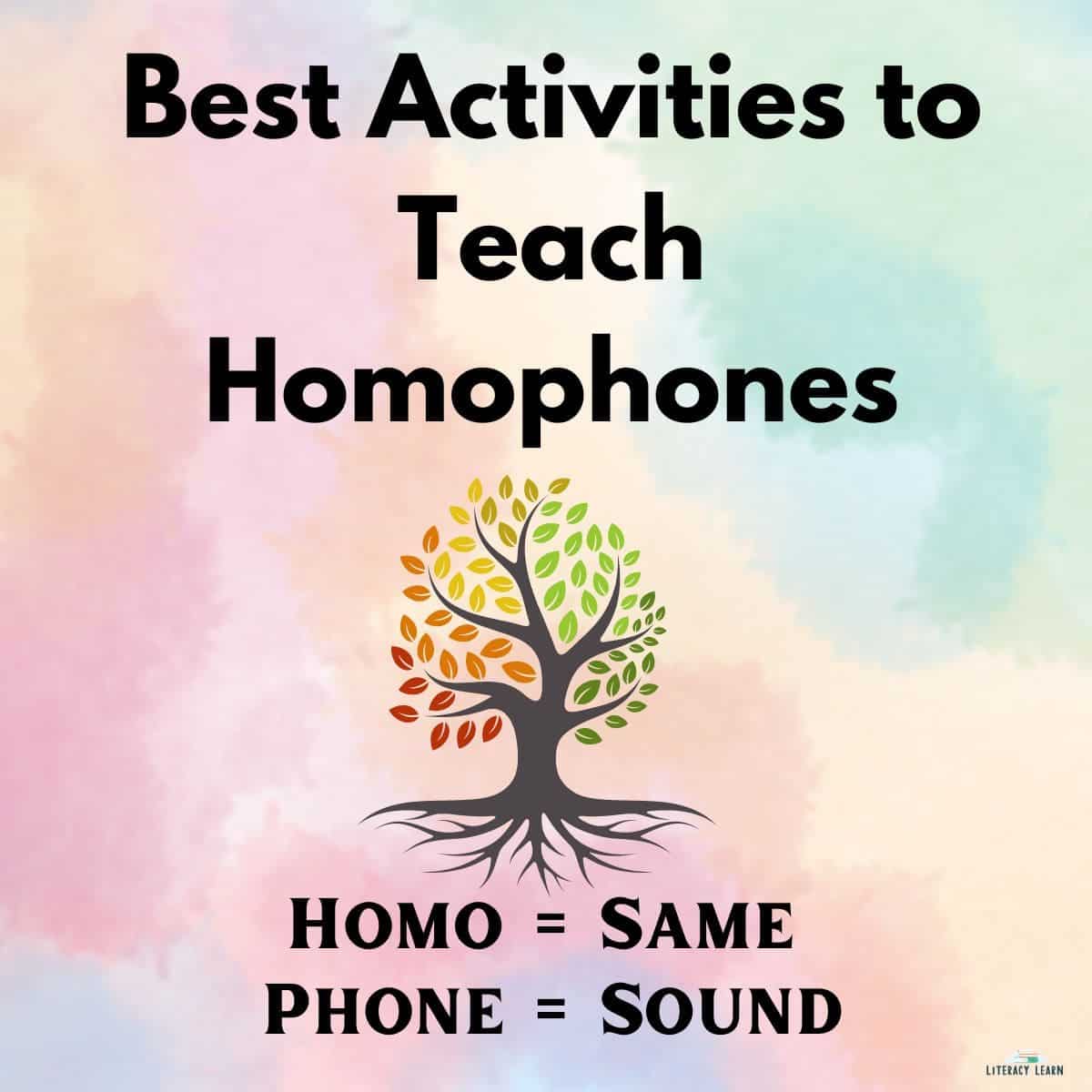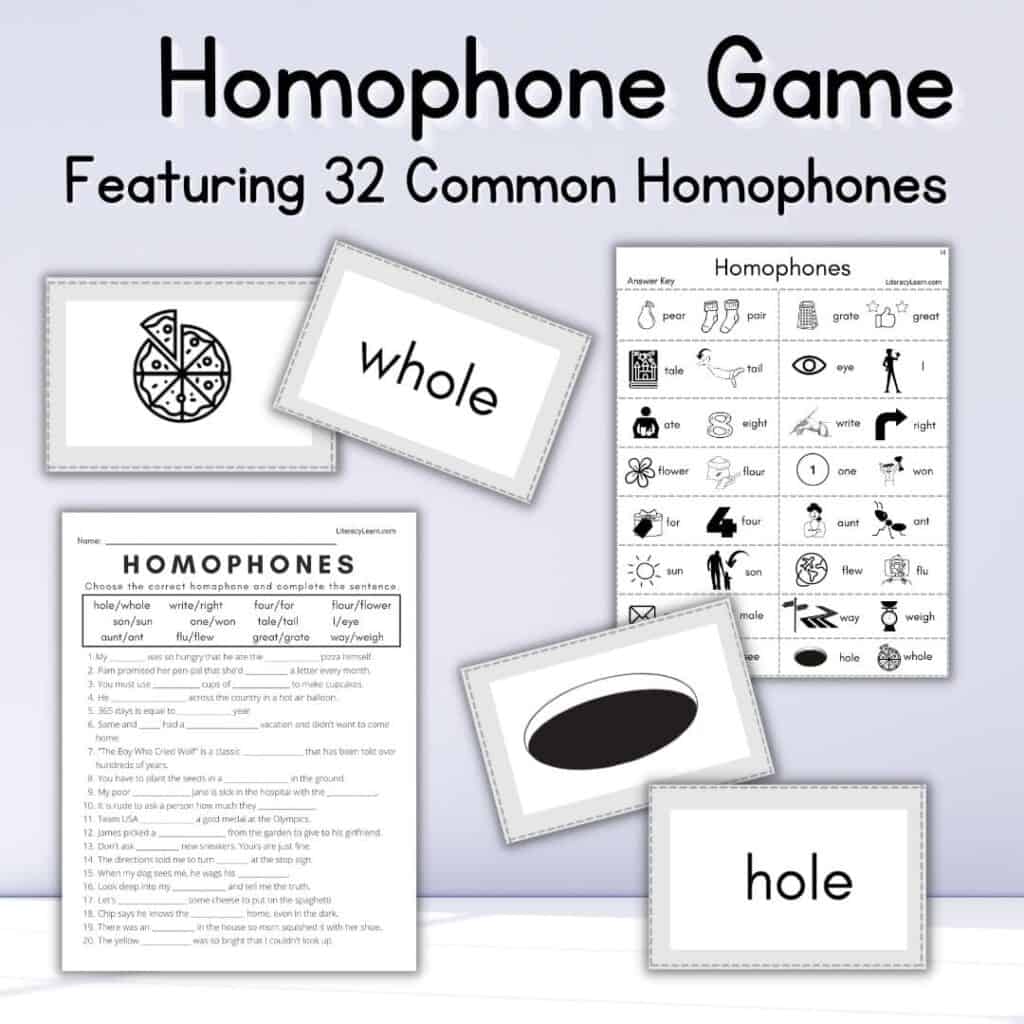Best Activities to Teach Homophones
This post may contain affiliate links. As an Amazon affiliate, we earn from qualifying purchases.
Read all about the BEST instructional strategies and activities for teaching homophones. Included are sample activities and best practice strategies to help!

What are Homophones?
Homophone is a word made up of two Greek bases – homo and phone. In Greek, homo means same and phone means sound. The translation of the word literally means: Same sound.
👉 Definition: Homophones are words that sound exactly the same, but have different meanings and different spellings.
Homophone Examples
- I/eye
- ad/add
- break/brake
- knew/new
- know/no
- mail/male
- meet/meat
- one/won
- our/hour
- pail/pale
- your/you’re
- its/it’s
- there/their/they’re
👉 Get our full list of homophones!
Why Teach Homophones?
Homophones are a large part of the English language, so it’s important that we teach them. Homophones need to be taught explicitly since no two are the same.
👉 Students must see the written word and connect it with meaning.
As a teacher, this can be an overwhelming skill to teach because there are so many homophones in the English language! But it’s important that homophones are taught in a particular way so that the brain can match the written word with its meaning.

Activities to Teach Homophones
The four BEST strategies and activities to best teach homophones are the explicit teaching of homophones, gamifying the experience, making literature connections, and using intentional activities for spiral review and repeated exposure.
1. Explicitly Teach Homophones
Because there are so many homophones in our language, you will need to explicitly teach them to students. You will need to teach their pronunciations, spellings, and meanings.
It’s best practice to focus on one word in each homophone set at a time. Spend time really digging deep into the spelling and meaning of one of the words. This will provide children with the exposure, consistency, and repetition they’ll need to really learn this word.
Once that word is a known sight word where kids can read it, spell it, and know the meaning, then move onto the second word in the homophone set. This will help minimize confusion for students between the words, spelling, and definitions.
It is sometimes okay to teach two homophones together, especially to our older students who already know the phonics concepts and definitions of some of the the more common homophone words.
For example, kids in second grade should know the word ‘see’ They’ve learned the phonics concept of Vowel Team EE, and they know the meaning as vision or what you do with your eyes.
‘See’ is a word they can quickly recognize, read, and spell independently. So it would be fine to introduce see & sea together as a homophone pair at one time.
Homophones & Phonics
One thing to note is that you should teach homophones with phonics patterns that students have been taught. For example, once you teach A-E and Vowel Team AI, that would be a perfect time to introduce the homophones male/mail.
If you need to teach words with irregular spelling patterns or ones you haven’t yet taught, use Elkonin boxes to map the word. Be sure to teach the irregular parts of the word as ones they need to memorize by heart.
Homophones & Morphology
This is the PERFECT way to incorporate morphology into your lessons…and it’s such a powerful tool! When teaching the concept of homophones, break apart the word into the Greek bases.
Have your students write word sums (homo + phone = homophone) and show them how the Greek bases tell us the meaning of the word: Homophones are words that sound the same.
2. Use Games
Gamifying concepts is so important, especially for our struggling students who need many repeated exposures.
You may not have a ton of time to spend on homophones, so using games, activities, and the occasional center activity focused on homophones are great ideas.
Be sure you have explicitly taught these homophones so that kids can be successful as they play.

3. Literature Connections
📚 Did you grow up reading the Amelia Bedilia books? She is famous for her funny homophone mix-ups!
Here are some additional read aloud books targeted toward teaching the concept of homophones:
- “Dear Dear: A Book of Homophones” by Gene Barretta.
- They’re Up to Something in There: Understanding There, Their, and They’re by Cari Meister.
- “How Much Can a Bare Bear Bear?: What Are Homonyms and Homophones?” by Brian Cleary.
Kids will love these silly books and the way they teach homophones!
4. Use Activities for Repeated Review
Use activities that will provide repetition for students to master the spelling and meaning of homophones. Use word cards, pictures, anchor charts, cloze sentences, and other activities to practice.
Grab our FREE homophone worksheets book so kids can keep an ongoing account of the homophone pairs they’ve learned!
For more ideas to increase vocabulary, visit our posts about using semantic mapping and alphaboxes in your classroom.
Related Posts
- Printable Homophones Worksheet Booklet
- Spelling Practice Tic Tac Toe
- Syllable Division for VCCV Words
- Syllable Types: Everything you need to know
- Context Clues Mini-Books


